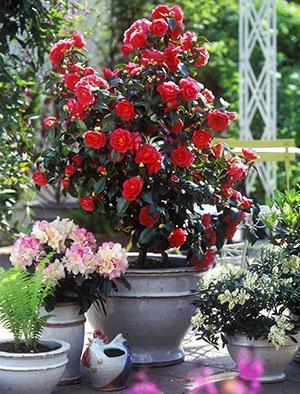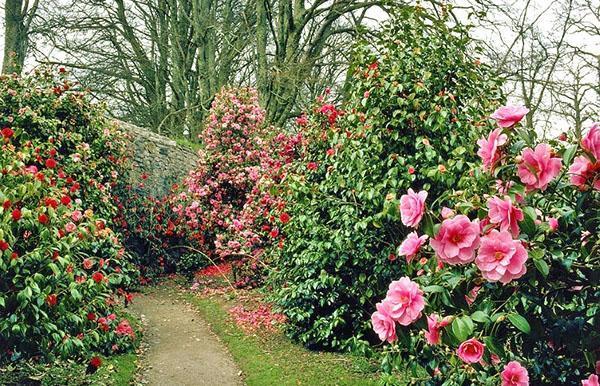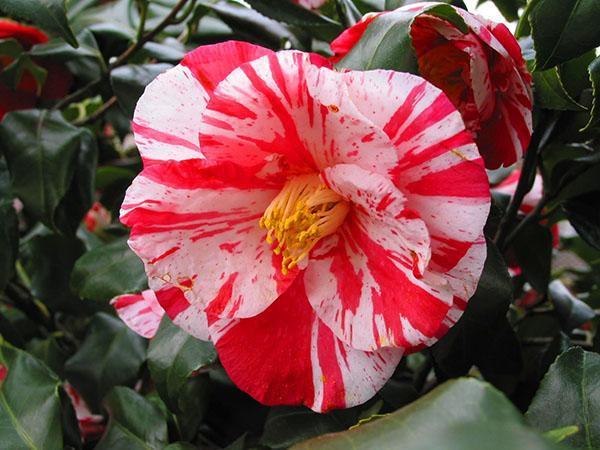We take care of Japanese camellia correctly
 Among the representatives of the Theaceae family, Japanese camellia or Camellia japonica occupies a special place because of its amazing decorativeness, the variety of existing varieties and the possibility of growing both in the open air and at home.
Among the representatives of the Theaceae family, Japanese camellia or Camellia japonica occupies a special place because of its amazing decorativeness, the variety of existing varieties and the possibility of growing both in the open air and at home.
The native land of the plant is the mountain forests of China, as well as the island of Taiwan, the southern regions of Japan and the Korean Peninsula. In nature, Japanese camellia looks like a medium-sized tree or shrub about 6 meters high.
The plant:
- sparse, but rather voluminous crown;
- pointed elliptical leaves up to 11 cm long and about 6 cm wide, with a leathery glossy surface, on which diverging veins are clearly visible;
- large single or paired flowers emerging from the leaf sinuses.

Not unusual:
- spotted and striped corollas;
- semi-double forms with a fluffy yellow center;
- Terry flowers of Japanese camellia, indistinguishable from the graceful garden rose.
 The flower retains its vibrancy and juiciness for almost a month, and then, after pollination, a fruit appears in its place, inside which several large seeds ripen.
The flower retains its vibrancy and juiciness for almost a month, and then, after pollination, a fruit appears in its place, inside which several large seeds ripen.
Conditions for keeping a Japanese camellia flower
If the camellia feels comfortable in the garden and is not too demanding to care for, then in indoor conditions a large flowering plant is a test of the knowledge and patience of a grower.
With a lack of attention or illiterately organized care, Japanese camellia at home can drop the already formed buds. And sometimes the plant even gets rid of the leaves.
 The culture is best acclimatized in a winter garden or greenhouse, where it is allocated a place where, throughout the year, the duration of daylight hours will be at least 12-14 hours. If the camellia lacks lighting, it refuses to bloom or does very sparingly.
The culture is best acclimatized in a winter garden or greenhouse, where it is allocated a place where, throughout the year, the duration of daylight hours will be at least 12-14 hours. If the camellia lacks lighting, it refuses to bloom or does very sparingly.
While buds are forming on the shrub, do not touch, move or rotate the pot. A capricious beauty can part with the buds, but when the flowers of the Japanese camellia open, she can be without fear:
- rearrange to the best place in the room;
- take out into the open air, where the crown will not be threatened by direct sunlight;
- put on a light loggia.
 In spring and summer, when the plant is actively growing, camellias are comfortable at the temperatures usual for the house, but from autumn the conditions should change. The buds are laid at 5–6 ° C, and the oriental beauty can achieve long and lush flowering at 8–12 ° C.
In spring and summer, when the plant is actively growing, camellias are comfortable at the temperatures usual for the house, but from autumn the conditions should change. The buds are laid at 5–6 ° C, and the oriental beauty can achieve long and lush flowering at 8–12 ° C.
For camellia, high humidity is important, it can be maintained with the help of improvised means, household appliances and regular washing of the crown with warm boiled water.
Watering, feeding and other care of the Japanese camellia
 Japanese camellia care consists of:
Japanese camellia care consists of:
- from careful watering, the intensity and frequency of which depends on the season and condition of the plant;
- of top dressing in the spring and summer;
- from pruning carried out in the second half of autumn and allowing the culture to maintain a compact crown at home;
- from a transplant of an overgrown bush.
While the green pet is blooming, it needs increased attention. The plant is watered very carefully, because in the cold water from the surface of the soil evaporates slowly, and it is not always easy to determine the moisture content of the soil at the roots.
If the root system stays in the soil saturated with moisture for a long time, rot and other infections cannot be avoided.
 A little lemon juice or vinegar is added to the settled irrigation water, which improves the well-being of the Japanese camellia and, as in the photo, gives brightness to the flowers.
A little lemon juice or vinegar is added to the settled irrigation water, which improves the well-being of the Japanese camellia and, as in the photo, gives brightness to the flowers.
At the budding stage, the shrub should receive regular support in the form complex fertilizer for azaleas... Top dressing is carried out after 10-14 days, and in the summer, the plant can be fertilized only once a month.
Transplant of Japanese camellia
 Young specimens of Japanese camellia are transferred to a new pot annually, but the older the plant, the less often this procedure, unpleasant for the shrub, is required.
Young specimens of Japanese camellia are transferred to a new pot annually, but the older the plant, the less often this procedure, unpleasant for the shrub, is required.
It is necessary to carry out the transshipment of the camellia before the growth is activated, otherwise the culture will take a long time and painfully acclimatize. If there is no urgent need for a transplant, you can simplify the care of the Japanese camellia by replacing only the top layer of soil in the pot.
For a Japanese camellia indoor flower, an acidic substrate with a pH of about 3.0–5.0 units is needed. If the soil is less or more acidic, this will affect the condition and flowering of the shrub.
The easiest way to plant a capricious plant is to purchase ready-made soil for azaleas, and then occasionally increase the acidity by adding citric or acetic acid to the irrigation water.